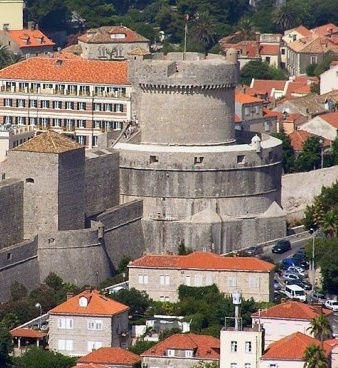

Tower Minčeta (Tvrđava Minčeta), a monumental round fortress integrated into Dubrovnik's UNESCO-listed city walls in Croatia, stands as the highest and most iconic point of the city's medieval fortifications. Dominating the northwestern corner of the Old Town, it overlooks the landward approach and offers panoramic vistas of the Adriatic Sea, terracotta rooftops, and surrounding landscape. Constructed primarily in the mid-15th century amid escalating Ottoman threats, the tower spans a substantial footprint with walls up to 6 meters thick, reaching a height that makes it a symbol of Dubrovnik's unyielding defense during the Republic of Ragusa era (1358–1808). Measuring approximately 20–25 meters in diameter at its base, it forms part of the 2-kilometer-long wall circuit, blending functional military design with aesthetic grandeur. Today, it attracts over a million visitors annually as a key stop on wall walks, famed not only for its historical resonance but also as a filming location for Game of Thrones (the House of Undying in Qarth), where its imposing silhouette enhanced scenes of intrigue and fantasy. Functioning as both a viewpoint and cultural exhibit space, it houses a small museum in its excavated basement, displaying artifacts like a 16th-century cannon foundry, while flying the Libertas flag—a nod to the republic's motto of freedom—during summer festivals.
The origins of Tower Minčeta trace to 1319, when local architect Nicifor Ranjina erected a quadrilateral fort on land owned by the prominent Menčetić (Minčeta) family, as part of Dubrovnik's early defenses against regional powers like Venice and the Ottoman Empire. This initial structure sufficed for over a century, but the fall of Constantinople in 1453 and Bosnia in 1463 heightened fears of Turkish invasion, prompting the Republic of Ragusa to fortify its landward vulnerabilities. In 1461, Florentine architect Michelozzo di Bartolomeo was commissioned to redesign it, incorporating advanced warfare adaptations amid Pope Pius II's support for Italian engineers in bolstering Adriatic defenses. Disagreements over his plans (including for the nearby Rector's Palace) led to his departure in 1464, after which Zadar-based sculptor and architect Giorgio da Sebenico (Juraj Dalmatinac) completed the tower, adding its signature elements. During its operational peak, the tower was armed with nine guns, including a bronze cannon by local craftsman Ivan Rabljanin, reflecting Dubrovnik's self-reliant armament production. It withstood sieges, earthquakes (notably 1667), and modern conflicts like the 1991–1992 Homeland War, where it sustained minor damage from shelling but symbolized resilience. In 2004, an adjacent water reservoir and aqueduct remnants were restored, revealing medieval infrastructure ties destroyed in the 19th century for road construction. Post-Yugoslav independence, conservation efforts have preserved it within UNESCO's 1979-inscribed Old Town, emphasizing its role in Croatia's cultural heritage.
Tower Minčeta exemplifies the transition from medieval to Renaissance military architecture, fusing robust functionality with ornamental flair in local limestone construction. Its core is the 1460s round tower—designed by Michelozzo—enveloping the original 1319 quadrilateral base, with walls 6 meters thick to withstand cannon fire and a system of low scarp walls for added stability against sieges. Protected gun ports (embrasures) punctuate the facade, allowing defenders to fire while minimizing exposure, a nod to evolving gunpowder tactics. Juraj Dalmatinac's contributions include the high, narrow upper tower and the distinctive Gothic crown—a battlemented parapet overhanging like a stone corona, more symbolic of nobility and power than practical defense, evoking a sense of grandeur. Internally, a steep, winding staircase of 750 steps leads to the summit, navigating vaulted chambers and narrow passages; the basement, excavated to reveal a 16th-century cannon foundry (now a museum), adds subterranean depth. The design integrates seamlessly with the city walls' undulating terrain, its circular form optimizing resistance to artillery while providing 360-degree surveillance. Subtle Renaissance influences appear in balanced proportions and sculpted details, contrasting the austere Gothic base, making it a pinnacle of Adriatic fortification engineering.
As a emblem of "unconquerable Dubrovnik," Tower Minčeta encapsulates the Republic of Ragusa's diplomatic and martial ingenuity, safeguarding its independence amid Ottoman expansions and embodying the "Libertas" ideal through its enduring presence. Its strategic landward defense role complemented sea-facing bastions, contributing to the walls' UNESCO status as an exemplary medieval ensemble. Culturally, it ties to festivals like the Dubrovnik Summer Festival (July–August), where the Libertas flag flies, and inspires modern media, boosting tourism. For visitors in 2025, access is via Dubrovnik City Walls tickets, priced at €40 for adults (€15 for children under 18; €20 off-season from December 1–February 28), including Fort Lovrijenac—purchase online or at entrances to skip lines. Opening hours vary seasonally: typically 8:00 AM–7:30 PM in peak summer (confirm via dubrovnikcity.com or apps), with early entry recommended to beat crowds and heat. Start at Pile Gate (western entrance) and head right for a counterclockwise walk; the tower is the first major landmark, requiring fitness for the 750-step climb—wear comfortable shoes, bring water, and avoid midday sun. Accessibility is limited (no elevators; steep stairs), but guided tours (€50+) like the "Minčeta Tower Secret Tunnels" offer deeper insights into hidden passages. Located at the northern walls (near Poljana Paška Babića), it's a 5-minute walk from Pile bus stop (lines 1A/B, 3, 8); parking is outside the car-free Old Town. Tips: Arrive 10 minutes before opening for solitude; combine with a full wall circuit (1–2 hours); photography is encouraged from the top for bird's-eye views, but drones are prohibited. As of September 2025, no major closures are reported, though check tzdubrovnik.hr for updates amid peak-season crowds.